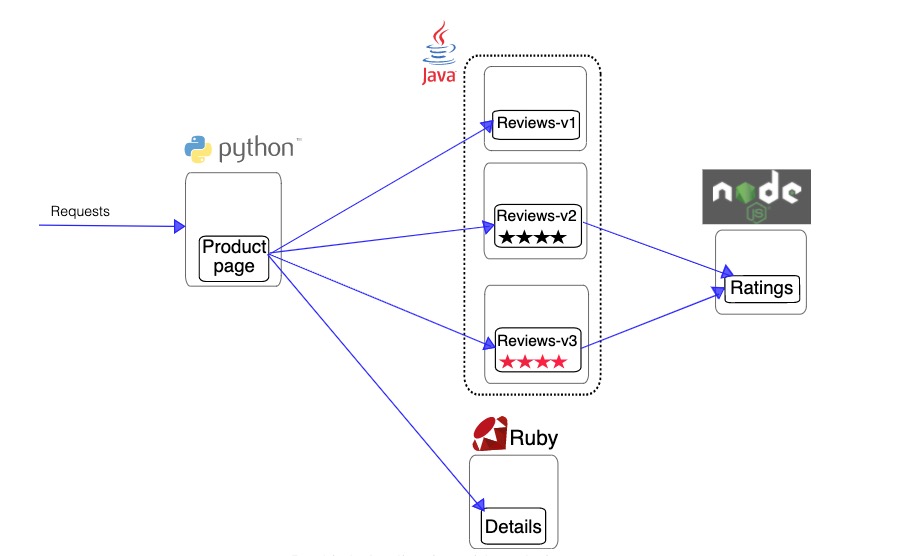Progressive Rollout with Istio
Introduction
The application deployment model in KubeVela is designed and implemented with extreme level of extensibility at heart. Hence, KubeVela can be easily integrated with any existing tools to superpower your application delivery with modern technologies such as Service Mesh immediately, without writing dirty glue code/scripts.
This guide will introduce how to use KubeVela and Istio to do an advanced canary release process. In this process, KubeVela will help you to:
- ship Istio capabilities to end users without asking them to become an Istio expert (i.e. KubeVela will provide you a rollout trait as abstraction);
- design canary release steps and do rollout/rollback in a declarative workflow, instead managing the whole process manually or with ugly scripts.
We will use the well-known bookinfo application as the sample.
Preparation
If your cluster haven't installed Istio. Install the Istio cluster plugin.
vela addon enable istio
Otherwise, you just need apply these 4 YAML files under this path
The default namespace needs to be labeled so that Istio will auto-inject sidecar.
kubectl label namespace default istio-injection=enabled
Initial deployment
Deploy the Application of bookinfo:
kubectl apply -f https://raw.githubusercontent.com/kubevela/kubevela/master/docs/examples/canary-rollout-use-case/first-deploy.yaml
The component architecture and relationship of the application are as follows:

This Application has four Components, productpage, ratings, details components configured with anexpose Trait to expose cluster-level service.
And reviews component have a canary-traffic Trait.
The productpage component is also configured with an istio-gateway Trait, allowing the Component to receive traffic coming from outside the cluster. The example below show that it sets gateway:ingressgateway to use Istio's default gateway, and hosts: "*" to specify that any request can enter the gateway.
...
- name: productpage
type: webservice
properties:
image: docker.io/istio/examples-bookinfo-productpage-v1:1.16.2
port: 9080
traits:
- type: expose
properties:
port:
- 9080
- type: istio-gateway
properties:
hosts:
- "*"
gateway: ingressgateway
match:
- exact: /productpage
- prefix: /static
- exact: /login
- prefix: /api/v1/products
port: 9080
...
You can port-forward to the gateway as follows:
kubectl port-forward service/istio-ingressgateway -n istio-system 19082:80
Visit http://127.0.0.1:19082/productpage through the browser and you will see the following page.

Canary Release
Next, we take the reviews Component as an example to simulate the complete process of a canary release, and first upgrade a part of the component instances, and adjust the traffic at the same time, so as to achieve the purpose of progressive canary release.
Execute the following command to update the application.
kubectl apply -f https://raw.githubusercontent.com/kubevela/kubevela/master/docs/examples/canary-rollout-use-case/rollout-v2.yaml
This operation updates the mirror of the reviews Component from the previous v2 to v3. At the same time, the Rollout Trait of the reviews Component specifies that the number of target instances to be upgraded is two, which are upgraded in two batches, with one instance in each batch.
In addition, a canary-traffic Trait has been added to the Component.
...
- name: reviews
type: webservice
properties:
image: docker.io/istio/examples-bookinfo-reviews-v3:1.16.2
port: 9080
volumes:
- name: wlp-output
type: emptyDir
mountPath: /opt/ibm/wlp/output
- name: tmp
type: emptyDir
mountPath: /tmp
traits:
- type: expose
properties:
port:
- 9080
- type: rollout
properties:
targetSize: 2
rolloutBatches:
- replicas: 1
- replicas: 1
- type: canary-traffic
properties:
port: 9080
...
This update also adds an upgraded execution Workflow to the Application, which contains three steps.
The first step is to upgrade only the first batch of instances by specifying batchPartition equal to 0. And use traffic.weightedTargets to switch 10% of the traffic to the new version of the instance.
After completing the first step, the execution of the second step of the Workflow will enter a pause state, waiting for the user to verify the service status.
The third step of the Workflow is to complete the upgrade of the remaining instances and switch all traffic to the new component version.
...
workflow:
steps:
- name: rollout-1st-batch
type: canary-rollout
properties:
# just upgrade first batch of component
batchPartition: 0
traffic:
weightedTargets:
- revision: reviews-v1
weight: 90 # 90% shift to new version
- revision: reviews-v2
weight: 10 # 10% shift to new version
# give user time to verify part of traffic shifting to newRevision
- name: manual-approval
type: suspend
- name: rollout-rest
type: canary-rollout
properties:
# upgrade all batches of component
batchPartition: 1
traffic:
weightedTargets:
- revision: reviews-v2
weight: 100 # 100% shift to new version
...
After the update is complete, visit the previous URL multiple times in the browser. There is about 10% probability that you will see the new page below,

It can be seen that the new version of the page has changed from the previous black five-pointed star to a red five-pointed star.
Continue with Full Release
If the service is found to meet expectations during manual verification, the Workflow needs to be continued to complete the full release. You can do that by executing the following command.
vela workflow resume book-info
If you continue to verify the webpage several times on the browser, you will find that the five-pointed star will always be red.
Rollback to The Old Version
During the manual verification, if the service does not meet the expectations, you can terminate the pre-defined release workflow and rollback the instances and the traffic to the previous version.
kubectl apply -f https://raw.githubusercontent.com/kubevela/kubevela/master/docs/examples/canary-rollout-use-case/rollback.yaml
This is basically updates the workflow to rollback step:
...
workflow:
steps:
- name: rollback
type: canary-rollback
Under the hood, it changes:
- the Rollout spec to target to the old version, which rolls replicas of new versions to the old version and keeps replicas of old version as is.
- the VirtualService spec to shift all traffic to the old version.
- the DestinationRule spec to update the subsets to only the old version.
You see?! All the complexity of the work is kept away from users and provided in a simple step!
Continue to visit the website on the browser, you will find that the five-pointed star has changed back to black.